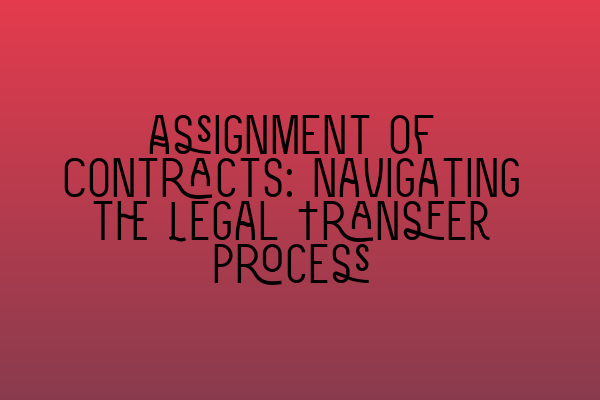Assignment of Contracts: Navigating the Legal Transfer Process
Contracts are the backbone of any business transaction. They establish the rights and responsibilities of the parties involved and ensure that agreements are upheld. However, there may be situations where one party needs to transfer their contractual obligations to another party. This is where the assignment of contracts comes into play.
In this article, we will explore the concept of assignment of contracts, the legal process involved, and how to navigate it successfully.
What is Assignment of Contracts?
The assignment of contracts refers to the legal transfer of one party’s rights and obligations under a contract to another party. This transfer can occur as a result of various reasons, including mergers and acquisitions, reorganizations, or the need for subcontracting. By assigning a contract, the assignor essentially passes on their contractual duties and entitlements to the assignee.
It is important to note that not all contracts can be assigned. Some contracts may contain clauses that prohibit or limit assignment, while others may require the consent of all parties involved. Therefore, it is crucial to review the terms of the contract thoroughly before attempting to assign it.
The Legal Transfer Process
The process of assigning a contract generally involves the following steps:
- Reviewing the Contract: The first step is to carefully review the terms of the contract to determine if assignment is permitted and if any specific requirements are outlined.
- Obtaining Consent: If the contract requires the consent of all parties involved, it is necessary to approach them and seek their approval for the assignment.
- Preparing an Assignment Agreement: Once consent is obtained, the assignor and assignee must prepare an assignment agreement. This agreement outlines the details of the assignment, including the rights and obligations being transferred, the effective date of the assignment, and any conditions or limitations.
- Notifying the Counterparty: The next step is to formally notify the counterparty of the assignment. This notification should include a copy of the assignment agreement and any other relevant documents.
- Record Keeping: It is essential to maintain proper records of the assignment, including all correspondence, agreements, and notifications exchanged between the parties involved. These records serve as evidence of the assignment and can be helpful in resolving any potential disputes in the future.
By following these steps, both the assignor and assignee can ensure a smooth and legally valid transfer of the contract.
Key Considerations
While navigating the assignment of contracts, it is crucial to keep in mind some key considerations:
- Legal Advice: Seeking legal advice is advisable to ensure that all legal requirements are met and that the assignment is carried out without any negative repercussions.
- Consent: If the contract requires the consent of all parties involved, it is essential to obtain this consent before proceeding with the assignment.
- Assignment Clause: Understanding the assignment clause in the contract is crucial. This clause governs the rights and limitations surrounding assignment, including any conditions or restrictions.
- Notification: Promptly notifying the counterparty of the assignment is necessary to avoid any breach of contract claims. This notification should be provided in writing and include all relevant details of the assignment.
By considering these factors and following the proper legal procedures, businesses can successfully navigate the assignment of contracts and ensure a smooth transfer of obligations and rights.
Conclusion
The assignment of contracts is a complex legal process that requires careful consideration and adherence to established procedures. By reviewing the contract, obtaining consent, preparing an assignment agreement, notifying the counterparty, and maintaining comprehensive records, businesses can navigate the assignment process successfully. Seeking legal advice and understanding key considerations adds an extra layer of protection and ensures compliance with contractual obligations.
For more information on contract law and the SQE exams, please check out these related articles:
